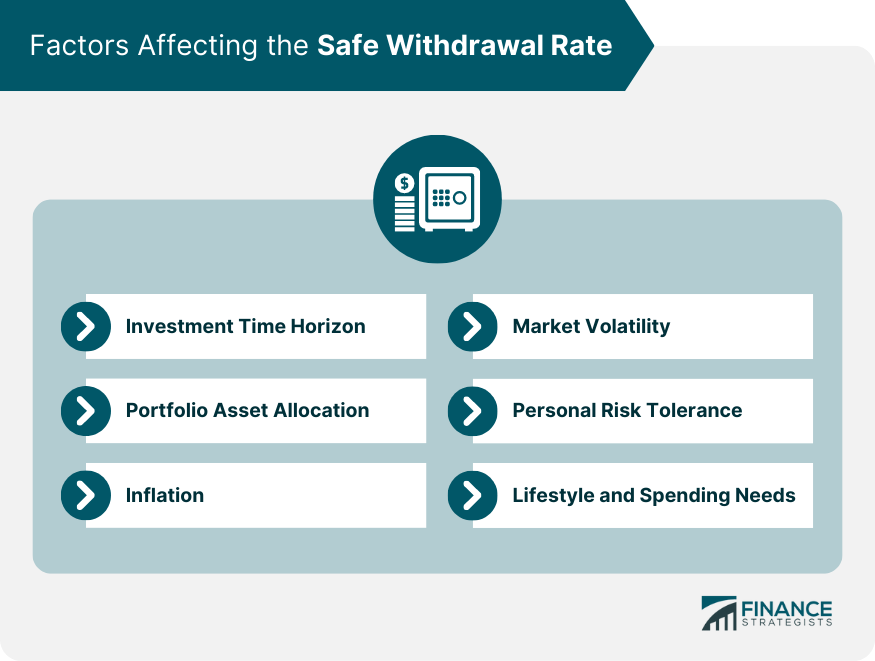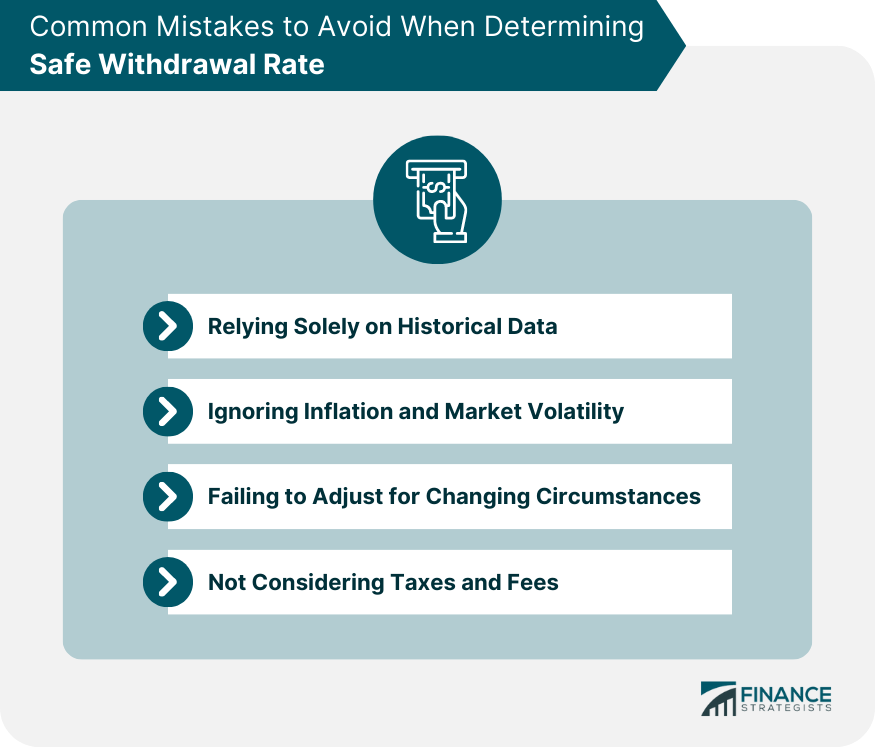A safe withdrawal rate is the percentage of a retiree's investment portfolio that can be withdrawn annually, adjusted for inflation, without significantly increasing the risk of running out of money during their retirement years. Determining a safe withdrawal rate is essential to ensure a stable and sustainable retirement income. Determining a safe withdrawal rate plays a crucial role in retirement planning and financial stability, as it helps retirees balance their spending needs with the preservation of their investment portfolio. By adhering to a safe withdrawal rate, retirees can avoid the risk of outliving their savings while enjoying a comfortable retirement. A well-calculated safe withdrawal rate can provide peace of mind for retirees, ensuring that their investments last throughout their retirement while meeting their financial needs. This rate is a critical component of a comprehensive retirement plan, as it directly influences the retiree's lifestyle, financial security, and overall well-being. The length of time a retiree expects their investments to last, or their investment time horizon, is a crucial factor in determining a safe withdrawal rate. A longer time horizon typically requires a more conservative withdrawal rate, while a shorter time horizon may allow for more aggressive withdrawals. The mix of investments in a retiree's portfolio, or their asset allocation, can significantly impact the sustainability and safety of their withdrawal rate. A well-diversified portfolio with a balance of stocks, bonds, and other assets can help manage risk and provide more stable returns, supporting a higher withdrawal rate. Inflation erodes the purchasing power of a retiree's income over time, making it necessary to adjust their withdrawal rate to account for rising costs. A safe withdrawal rate should take inflation into account to ensure that the retiree's income remains sufficient to cover their expenses throughout their retirement years. Market volatility can lead to fluctuations in the value of a retiree's investment portfolio, potentially affecting the sustainability of their withdrawal rate. By accounting for market volatility, retirees can develop a withdrawal strategy that adapts to changing market conditions and maintains the stability of their income. A retiree's personal risk tolerance, or their comfort level with investment risk, can also influence their safe withdrawal rate. Those with a higher risk tolerance may be willing to accept a higher withdrawal rate with the understanding that it may involve greater fluctuations in their investment portfolio's value. The retiree's desired lifestyle and spending needs during retirement are critical factors in determining a safe withdrawal rate. Retirees with more modest spending needs may be able to sustain a higher withdrawal rate, while those with more extensive expenses may need to adopt a more conservative approach to preserve their savings. The 4% rule is a widely recognized guideline for determining a safe withdrawal rate in retirement planning. The rule suggests that retirees can withdraw 4% of their investment portfolio in the first year of retirement, adjusting the amount for inflation each subsequent year, with a high probability of their savings lasting for at least 30 years. The 4% rule is simple to understand and easy to apply, making it an attractive option for many retirees. Additionally, the rule has been tested and validated using historical market data, providing a reasonable level of confidence in its effectiveness. Despite its popularity, the 4% rule has several limitations and critiques. Some argue that the rule may be too conservative for certain retirees, while others point out that relying solely on historical market data may not accurately predict future market conditions. Additionally, the 4% rule may not account for individual circumstances, such as varying investment time horizons, risk tolerances, and spending needs, making it less suitable for some retirees. Variable withdrawal rate strategies adjust the withdrawal amount based on market performance and other factors, allowing for more flexibility in response to changing market conditions and personal circumstances. This approach can help retirees maintain their income stability while preserving their investment portfolio. The constant-dollar withdrawal strategy involves withdrawing a fixed dollar amount from the investment portfolio each year, adjusted for inflation. This approach provides a predictable income stream but may be less sustainable in the long run, especially during periods of poor market performance. In the constant-percentage withdrawal strategy, retirees withdraw a fixed percentage of their portfolio's value each year, regardless of market performance or inflation. This approach can help ensure that the portfolio lasts throughout retirement, but it may result in more significant income fluctuations. Dynamic withdrawal strategies involve adjusting the withdrawal rate based on a combination of factors, such as market performance, changes in personal circumstances, and inflation. These strategies aim to provide a more tailored approach to retirement income planning, balancing the need for income stability with the preservation of the investment portfolio. While historical market data can provide valuable insights into the potential performance of different withdrawal strategies, relying solely on this information can be misleading. Future market conditions may not mirror past trends, making it essential to consider a range of factors when determining a safe withdrawal rate. Failing to account for inflation and market volatility can lead to an unsustainable withdrawal rate, jeopardizing the retiree's financial stability. A well-designed withdrawal strategy should take these factors into account to ensure that the retiree's income remains sufficient and stable throughout their retirement years. Retirees should regularly review and adjust their withdrawal strategy in response to changes in personal circumstances, market conditions, or inflation. Failing to adapt to these changes can put the retiree's income and financial stability at risk. Taxes and fees can significantly impact the sustainability of a withdrawal strategy, making it essential to account for these costs when determining a safe withdrawal rate. Retirees should work with a financial advisor to optimize their withdrawal strategy for tax efficiency and minimize the impact of fees on their retirement income. Financial advisors can play an essential role in helping retirees determine a safe withdrawal rate tailored to their unique circumstances, financial goals, and risk tolerance. By developing a personalized retirement income plan, advisors can help ensure that retirees enjoy a stable and sustainable income throughout their retirement years. Financial advisors can also provide ongoing monitoring and adjustments to the withdrawal strategy as needed, accounting for changes in market conditions, personal circumstances, and inflation. This support helps ensure that the retiree's income remains stable and sufficient, even in the face of unexpected challenges or changes. Working with a financial advisor can help retirees manage the various risks and uncertainties associated with retirement income planning, such as market volatility, inflation, and changes in personal circumstances. Advisors can provide guidance and support in developing a withdrawal strategy that addresses these risks and promotes long-term financial stability. Determining a safe withdrawal rate is a critical aspect of retirement planning and financial stability. By identifying a sustainable rate that balances income needs with portfolio preservation, retirees can enjoy a comfortable retirement without the fear of outliving their savings. A one-size-fits-all approach to determining a safe withdrawal rate may not be suitable for every retiree, given the unique factors that can impact the sustainability of a withdrawal strategy. It is essential for retirees to consider their individual circumstances, such as investment time horizon, risk tolerance, and spending needs, when determining an appropriate withdrawal rate. Collaborating with a financial advisor can help retirees develop a tailored withdrawal strategy that considers their unique circumstances and financial goals. By providing personalized retirement income planning, ongoing monitoring, and adjustments, financial advisors can help ensure retirees enjoy a stable and sustainable income throughout their retirement years.What Is the Safe Withdrawal Rate?
Factors Affecting the Safe Withdrawal Rate
Investment Time Horizon
Portfolio Asset Allocation
Inflation
Market Volatility
Personal Risk Tolerance
Lifestyle and Spending Needs

Traditional 4% Rule
Overview and Historical Context
Advantages of the 4% Rule
Limitations and Critiques
Alternative Safe Withdrawal Rate Strategies
Variable Withdrawal Rates
Constant-Dollar Withdrawal Strategy
Constant-Percentage Withdrawal Strategy
Dynamic Withdrawal Strategies
Common Mistakes to Avoid When Determining Safe Withdrawal Rate
Relying Solely on Historical Data
Ignoring Inflation and Market Volatility
Failing to Adjust for Changing Circumstances
Not Considering Taxes and Fees

Role of Financial Advisors in Determining Safe Withdrawal Rate
Personalized Retirement Income Planning
Ongoing Monitoring and Adjustments
Managing Risks and Uncertainties
Conclusion
Safe Withdrawal Rate FAQs
A safe withdrawal rate is the maximum percentage of your retirement savings that you can withdraw annually while ensuring that your money lasts through retirement. It is typically recommended that retirees withdraw no more than 4% of their savings each year to avoid running out of money.
The safe withdrawal rate is calculated based on several factors, including the retiree's expected lifespan, expected investment returns, and inflation rate. Typically, it is based on historical returns and inflation rates, as well as Monte Carlo simulations that model different future scenarios.
No, the safe withdrawal rate varies depending on a variety of factors, including the retiree's age, risk tolerance, investment portfolio, and retirement goals. It's important to work with a financial advisor to determine the appropriate withdrawal rate for your specific situation.
Yes, the safe withdrawal rate can change over time due to changes in investment returns, inflation, and other factors. Retirees should monitor their portfolio and adjust their withdrawal rate as needed to ensure that they don't run out of money.
Some strategies for ensuring a safe withdrawal rate include diversifying your investment portfolio, managing risk through asset allocation, and implementing a dynamic withdrawal strategy that adjusts based on market conditions and other factors. Working with a financial advisor can also help retirees ensure that they have a sustainable retirement income plan in place.
True Tamplin is a published author, public speaker, CEO of UpDigital, and founder of Finance Strategists.
True is a Certified Educator in Personal Finance (CEPF®), author of The Handy Financial Ratios Guide, a member of the Society for Advancing Business Editing and Writing, contributes to his financial education site, Finance Strategists, and has spoken to various financial communities such as the CFA Institute, as well as university students like his Alma mater, Biola University, where he received a bachelor of science in business and data analytics.
To learn more about True, visit his personal website or view his author profiles on Amazon, Nasdaq and Forbes.











